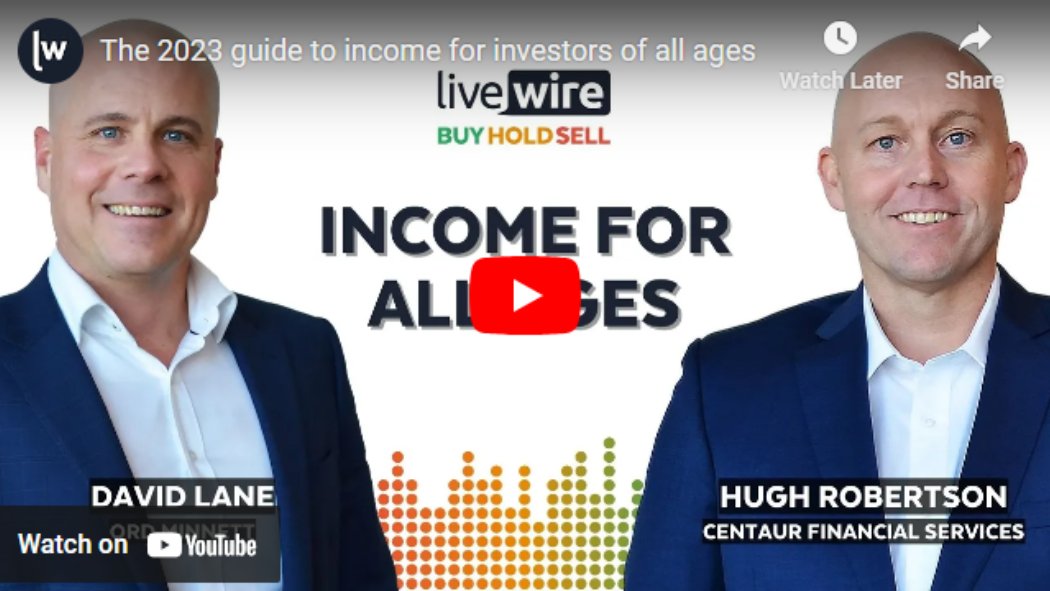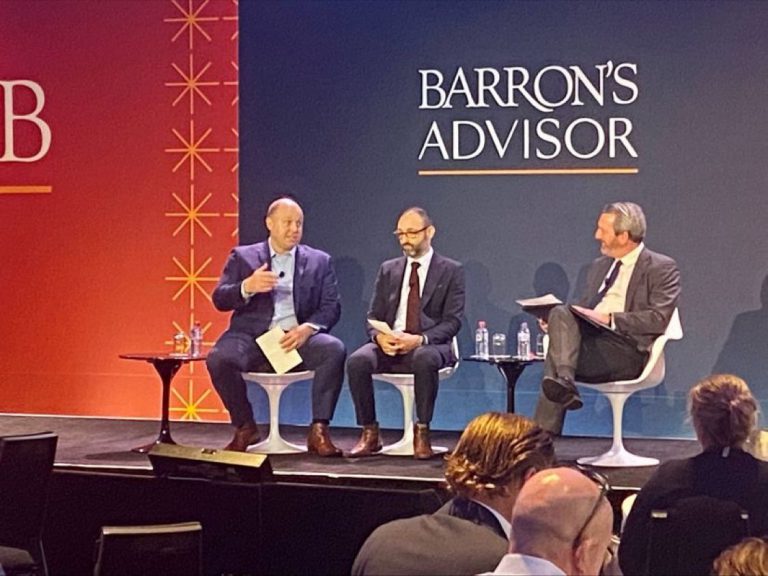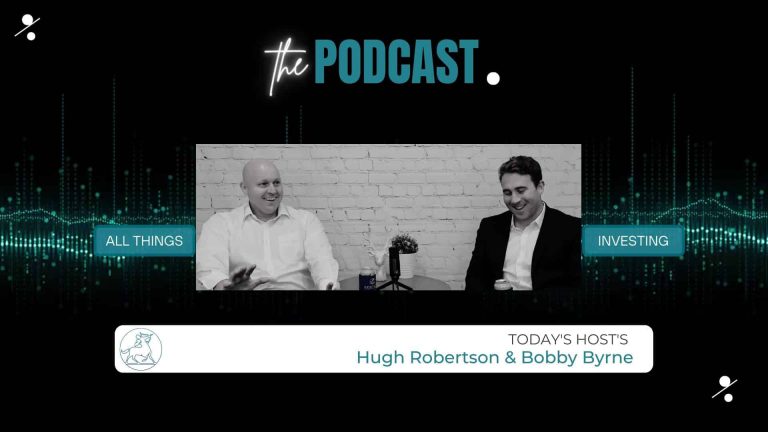Our very own Hugh Robertson joins Livewire’s Chris Conway in yet another special Income Series edition of Buy Hold Sell.
In this episode, Livewire drew on the Investment expertise of Hugh Robertson from Centaur Financial Services and David Lane from Ord Minnett.
As stated by Livewire in the release of this edition of Buy Hold Sell – Hugh and David share their views and tips for generating attractive passive income for all ages as a part of Livewire’s 2023 Income Series.
Note: This episode was filmed on Wednesday 14th June 2023. You can watch, listen or read an edited transcript below.
Watch by clicking the below video:
Edited Transcript
Chris Conway: Hello and welcome to Livewire’s Buy Hold Sell. My name is Chris Conway. Today, as part of Livewire’s annual Income Series, we’re taking a deep dive into the world of income generation for investors of all ages. To do that, I am joined by Hugh Robertson from Centaur Financial Services and David Lane from Ord Minnett. Thanks so much for joining us, gents. Very much appreciate you being here and thanks for making the trip from sunny Queensland. Our
David, let’s start with you. Bonds are back in the black and term deposits are yielding up to 5%. Who would’ve thought? How has this changed your approach to income-focused portfolios?
David Lane: Well, they’re back in fashion now. Two years ago we wouldn’t have even spoken about a term deposit but now we’ve actually – this week even – seen a couple that are yielding 5.2%. Yes, certainly for conservative investors, term deposits are coming back in as part of the portfolio from a defensive point of view and bonds, there are some really interesting corporate bonds that are available now. For a lot of our wholesale clients, we’re looking at those. Yields, 5.5% to 6.5% for AAA-rated investment-grade bonds. Again, that’s part of the portfolio that we’re now talking about again, whereas two years ago, we weren’t. Now it’s definitely part of the defensive part of the portfolio. It makes things a lot more interesting and when we’re fairly cautious on the equity side of the market, they fit in well as part of overall portfolio management for people.
Chris Conway: Hugh, how about you? How has your approach to income changed in this higher interest rate, higher inflation environment?
Hugh Robertson: We go back 15 months and we had a reserve bank governor tell us that interest rates weren’t going to go up until 2024. 13 board meetings later, we’ve had 12 rate rises. The conversation has changed and I think in a moment like this when the facts change, our views should change. We’ve had the go-go years in growth where equities did amazingly well when we had low interest rates, but now income comes back as a real pivotal player in the portfolio, especially for our retiree clients where we’re trying to generate sufficient income to keep pace with inflation, which has exceeded all of our expectations, i.e. might be a little bit stickier than we thought. It’s really nice to know that that total return composition now, instead of being 8% gross with 2% income, is now looking more like 5-6% income and then growth we’re not as reliant on.
I think from the retiree perspective, it’s a much more robust portfolio that can be created and it’s a really great time to revisit all the options that are available because for the past decade, most people probably haven’t really looked too much into corporate bonds, government bonds, treasuries, hybrids. So great to be having a discussion around that, about what people can do to have a better portfolio going forward
The biggest mistakes income investors are making in 2023
Chris Conway: Hugh, we’ll stay with you. What are some of the biggest mistakes investors are making when it comes to income at the moment?
Hugh Robertson: It’s a different time and people – it’s not their fault – but they will always chase the highest yield and that always presents alarm bells for us because sometimes they just chase the yield and they don’t look at the underlying risk/return matrix. For me, it’s always been unlisted property. That might be because during the global financial crisis, that’s what we saw. I feel there’s almost a yield trap in there. There’s an illiquidity trap there that they might not be able to get their money back even if they want it, and there’s a valuation trap. We’ve just seen Dexus last week sell a property for 17% below what it had valued it in December. We’re only in May.
They present real troubles to me. Maybe in the unlisted space those [properties] haven’t been marked to market appropriately. If you are entering into it now, you might not get the yield, you might not get the capital value, and you may not even be able to access it. For me, that’s the big risk for people if they’re chasing just that yield alone, relative to other options that are available right now.
Chris Conway: David, what about you? What is the biggest mistake you see when it comes to income investing?
David Lane: There’s a couple. When it’s looking at the really defensive parts of the portfolio, and we were talking about term deposits earlier, one of the risks is that people forget that it is actually a term. If you’ve got your money in there for 12 months, you can’t actually get it out and you pay … well, you used to pay high fees. Nowadays, you can’t even get that money out. So only put in money that you can afford to not touch for the term. Also taking into account the fact that when interest rates rise, the face value of a bond, if it’s a fixed-rate bond, actually declines. Although we talk about bonds as being a defensive part of the portfolio, they’re not riskless. There are risks involved, so you need to understand them.
Another thing that Hugh touched on a bit with the property, we also see that in the equity market is what’s called the dividend trap. So be wary of those companies that are looking at paying a high dividend. There could well be underlying reasons. The share price may have fallen significantly because the underlying business isn’t so good. Or it might be a mining company that’s had fantastic cash flow over the last few years but may not be able to continue to pay that dividend. You need to understand that just because the face value of the yield looks attractive, it’s not always going to be as appealing.
Income strategies for young people
Chris Conway: Let’s get to the reason why we are all here, the exciting part. Let’s talk the best income strategies for investors of all ages. Starting with young investors, those that are in the accumulation phase. David, we’ll stay with you.
VanEck Equal Weight ETF (ASX: MVW)
David Lane: For young investors, I really think that the best way to go is to still have a long-term horizon and have a growth impact as well. I would still be investing in inequities because you are able to get decent yield out of equities. The one that I’d look at would be MVW, which is the VanEck Eequal Weight ETF. That gives you exposure to your large-cap companies, but it actually spreads it across equally so you’re not just concentrating on your four major banks and BHP and Rio. That ETF has a yield of about 4%. It’s actually outperformed the ASX 200 in the last 12 months, three years, five years. That strategy provides good long-term income as well as some growth. For younger investors with a longer timeframe, I’d still be looking at something like that.
Chris Conway: Hugh, what about you? What’s your guidance for the young cohort out there?
iShares S&P/ASX 20 ETF (ASX: ILC)
Hugh Robertson: I’m a big fan of MVW. I think it’s a fantastic fund from VanEck. I’ve gone with the top 20, which is ILC. It’s from iShares. It’s a BlackRock top 20. The reason is the dividend now is 6.91%. That’s a great dividend for an accumulator. They can either use that to pay down their home loan, they can use that to help subsidise school fees, or the like. The top 20, so you’re in the bigger end of town. If we are going to go through some hard times, so if you’re thinking recession or again going back to global financial crisis time, think about what survived that economic winter. The big got bigger and some of the small ones went out of business.
For that, I think you’re getting a great dividend yield. I think you’re getting that protection and a lot of those businesses, by virtue of their size, have great bargaining power to relatively low debt levels, great bargaining power in terms of their pricing. I think that can do really well. The other aspect that I really like about that kind of fund is it rebalances quarterly. You’re not just going to have the top 20 and stay in that forever. As the top 20 composition changes, the investment options within that will change as well. I think that’s quite dynamic for a young accumulator and could do quite well over time.
Chris Conway: Hugh, I’ll stay with you for the next cohort, the middle-aged investors that are perhaps nearing retirement, what product would you recommend and why?
Income strategies for middle-aged investors
Betashares Australian Bank Senior Floating Rate Bond ETF (ASX: QPON)
Hugh Robertson: I’ve made some financial planning assumptions here and I’m going with that they’re already quite growth-oriented in their portfolio. We’re top-heavy on growth, we’re going into volatility, so I’m going to go the Betashare’s floating note fund ETF, which is QPON. That is looking at senior floating notes. 80% of that is in the big four banks. It’s very safe … it’s not exposed to duration risk, which really hurt our government and corporate bonds last year. It’s got a duration of zero, there is credit risk to some extent associated with it, but 80% of it’s with the big four banks, so we feel safe there. You’re getting a 5.1% yield on it. That’s above what we’re going to get in an online savings or a term deposit – possibly. But with the term deposit, we have inflexibility there.
We might not be able to access it when we want the money. It’s not necessarily paid monthly. Whereas with this we’ve got 5.1% paid monthly into our account. Now, if I’m thinking about that person leading up to retirement, what are they going to do with that? That might be building up a buffer and they could also allocate their distributions from the growth portfolio bucket of their portfolio into something like this, which is going to start building a safety bucket for them. That’s going to yield a really good income. Low cost, I think it’s 0.22%. So it just sits really nicely in a wheelhouse as a sort of cash alternative right now I feel.
Chris Conway: David, what about you? That middle-aged bracket, investors nearing retirement, what have you got for them?
iShares Edge MSCI Multifactor ETF (ASX: AUMF)
David Lane: I certainly agree with Hugh. I think that QPON is a great product and, again, that’s the defensive side. On the somewhat growth side, I’d be looking at AUMF, it’s the iShares’s multifactor ETF. It gives you a broad diversified portfolio of Australian stocks. Its yields about 6.8% at the moment. The way it develops its index is … it’s called Smart Beta and it’s got four different factors that it looks at. It looks at companies that are high quality, they’ve got momentum, they tend to be the larger companies. You are getting exposure to BHP, CSL, the four major banks, Rio Tinto, et cetera. But it’s really a good way to get exposure to that portfolio without having to do the thinking about it. It’s a fairly easy set-and-forget type long-term investment.
Income strategies for retirees
Chris Conway: Sounds like my kind of product if you don’t have to think about it, mate. David, I’ll stay with you. The final cohort, obviously those in retirement pension phase, what is a product that you have been recommending to your clients in that area?
Macquarie Group Capital Notes 3 (ASX: MQGPC)
David Lane: Well, again, they’re probably a little bit more conservative, will have a higher weighting towards your defensive part of the portfolio. We tend to like to use hybrids for a lot of that income for investors in the pension phase. The advantage that hybrids have is that you get the tax benefit back. They’ll pay a dividend that has franking credits attached. One of the ones that we like at the moment is the Macquarie Capital Note 3. MQGPC is the code for it. The reason we like it, it has a good yield, about 5.7%. When you take into account franking, that takes it up to about 6.8%. But it matures in 2024. You have a relatively short timeframe, which means that you then get that rollover.
When that comes to maturity, Macquarie will no doubt issue a new security and give you option to get into that. We like a lot of those shorter-dated hybrids at the moment. The other thing that’s important about hybrids in the current rising interest rate environment is that their yield is attached to the bank bill swap rate. As interest rates go up, the income that you receive on the hybrids goes up as well. You don’t have that capital risk that you might have with a bond with the face value dropping.
Chris Conway: Hugh, what about you to round it out for the retirees, what have you got for us?
Perpetual Australian Share Fund
Hugh Robertson: So again, the disclaimer, with the financial planning assumption, is they’ve already used their hybrids, they’ve used coupons. Now we’re going to look at their actual equity portfolio. The growth as a style, obviously got really hurt last year, but that was a beneficiary of really low interest rates. Even if interest rates sort of stay around about where they are, I’m going to go with the Perpetual Australian Share Fund. Vince Pezzullo runs that fund. He’s an excellent manager. The fund itself has been first or second quartile over all the time periods. What attracts me to that is I feel for the retiree, I want an active manager, I want a value manager, and I want that bottom-up real stock selection because I need someone who’s going to look at the debt levels within the business, the quality of the business, the earnings of the business, the management of the business, and that’s the four key characteristics that Perpetual look at.
I feel that’s going to give me my downside protection. I don’t want to get nerdy on the people listening, but the upside/downside capture, which we all love in our industry, that means that when the market goes up 10%, it goes up 10%, but when the market goes down 10%, it goes down 7%. It does offer an element of protection even within that equity sleeve in my portfolio. The yield’s been around 5-5.5% per annum averaged over the last five years. It’s still given us that good dividend, but it also gives me that growth because for my retiree, I still need to cover inflation risk and even with the yields we’re getting in the other portfolios, it’s not quite keeping pace with current inflation. And I’ve got longevity risk. I am going to probably live longer than I think, so I can’t go all defensive side. That would be my pick.
Chris Conway: Well, that’s all we have time for today. I hope you enjoyed that income special of Buy, Hold, Sell. If you enjoyed it as much as I did, make sure to give it a like and don’t forget to follow our YouTube channel because we’re adding lots of great content every single week.





































































